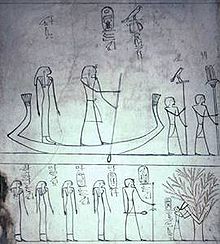
Sitre or Tia-Sitre, was the Great Royal Wife of Pharaoh Ramesses I of Egypt and mother of Seti I.
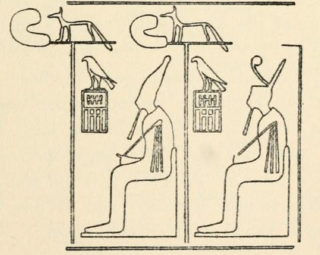
Djer is considered the third pharaoh of the First Dynasty of ancient Egypt in current Egyptology. He lived around the mid 31st century BC and reigned for c. 40 years. A mummified forearm of Djer or his wife was discovered by Egyptologist Flinders Petrie, but was discarded by Émile Brugsch.
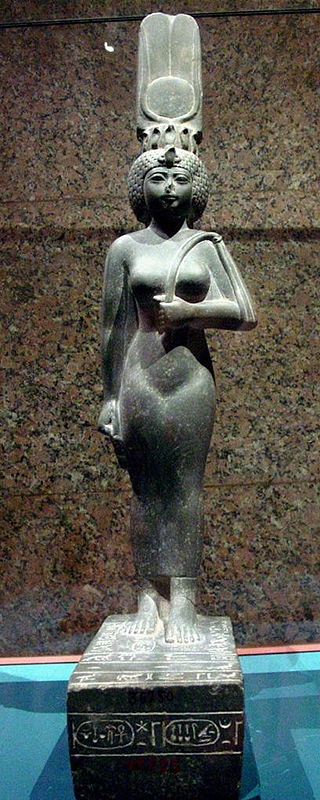
God's Wife of Amun was the highest-ranking priestess of the Amun cult, an important religious institution in ancient Egypt. The cult was centered in Thebes in Upper Egypt during the Twenty-fifth and Twenty-sixth dynasties. The office had political importance as well as religious, since the two were closely related in ancient Egypt.

Isetnofret was one of the Great Royal Wives of Pharaoh Ramesses II and was the mother of his successor, Merneptah. She was one of the most prominent of the royal wives, along with Nefertari, and was the chief queen after Nefertari's death.

Great Royal Wife, or alternatively, Chief King's Wife is the title that was used to refer to the principal wife of the pharaoh of Ancient Egypt, who served many official functions.
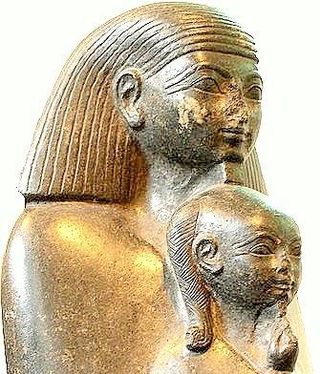
Neferure or Neferura was an Egyptian princess of the Eighteenth Dynasty of Egypt. She was the daughter of two pharaohs, Hatshepsut and Thutmose II. She served in high offices in the government and the religious administration of Ancient Egypt.
The Autobiography of Ahmose Pen Nekhbet is a tomb inscription from ancient Egypt, which is significant to Egyptology studies. Ahmose Pen Nekhbet was an ancient Egyptian official who started his career under Ahmose I and served all the pharaohs until Thutmose III. His autobiographical inscriptions are important for the understanding of the history of the early New Kingdom, though less detailed than those of his contemporary Ahmose, son of Ebana. In his tomb he mentions his brother Khaemwaset and his wife Ipu,. His tomb is located in Nekhen where it is given the designation EK2.

Nebtu was an ancient Egyptian, the wife of Thutmose III.
Mutnofret, also rendered as Mutneferet or Mutnefert, was a queen during the Eighteenth Dynasty of Egypt. She was a secondary wife of Thutmose I and the mother of his successor Thutmose II; Thutmose I's chief wife, however, was his sister Queen Ahmose, the mother of Hatshepsut.

Iaret was a Great Royal Wife from the middle of the Eighteenth Dynasty of Ancient Egypt.

Iset was a queen of the Eighteenth Dynasty of Egypt, and she was named after goddess Isis. She was a secondary wife or concubine of Thutmose II.
Amenemhat was a prince of the Eighteenth Dynasty of Egypt. He was the son of Pharaoh Thutmose III.

Tiaa or Tia'a was an ancient Egyptian queen consort during the Eighteenth Dynasty of Egypt. She was a "faceless concubine" during the time of Amenhotep II who withheld from her the title Great Royal Wife, but when her son Thutmose IV became pharaoh, he performed a revision of her status and gave her that title.
Hui or Huy was an ancient Egyptian priestess during the Eighteenth Dynasty. She was the mother of Merytre-Hatshepsut, the Great Royal Wife of Pharaoh Thutmose III.
Ipu was a royal nurse during the 18th Dynasty of ancient Egypt. She was the mother of Queen Satiah, Great Royal Wife of Pharaoh Thutmose III.
Meritamen, also spelled Meritamun, Merytamen, Meryetamen is an ancient Egyptian female name. Its male counterpart is Meryamen or Meryamun.

Isetnofret was a royal woman of Ancient Egypt and, as the Great Royal Wife of Pharaoh Merenptah, she became Isetnofret II.
Peksater (Pekerslo) was a Nubian queen dated to the Twenty-fifth Dynasty of Egypt.

The Eighteenth Dynasty of Egypt is classified as the first dynasty of the New Kingdom of Egypt, the era in which ancient Egypt achieved the peak of its power. The Eighteenth Dynasty spanned the period from 1550/1549 to 1292 BC. This dynasty is also known as the Thutmoside Dynasty) for the four pharaohs named Thutmose.
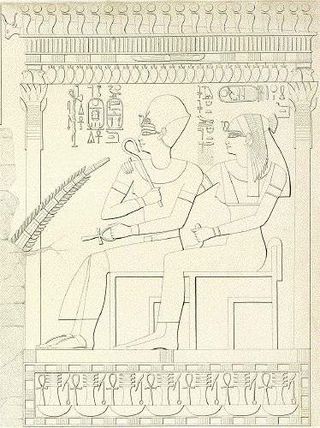
Merytre-Hatshepsut was the Great Royal Wife of Pharaoh Thutmose III after the death of Queen Satiah. She was the mother of Pharaoh Amenhotep II.
